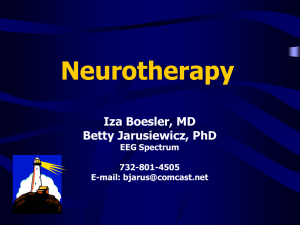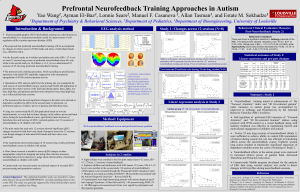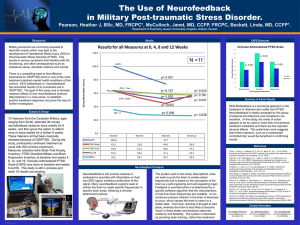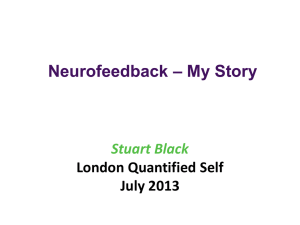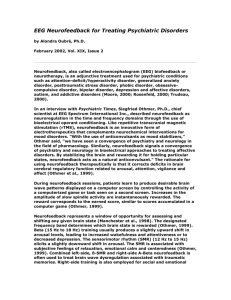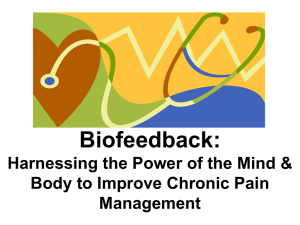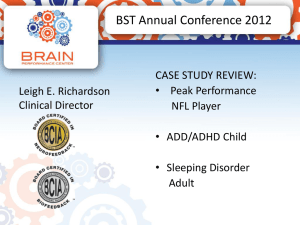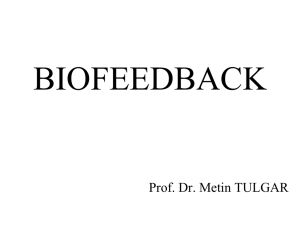to file - Edward Jacobs, Ph.D. & Associates
advertisement
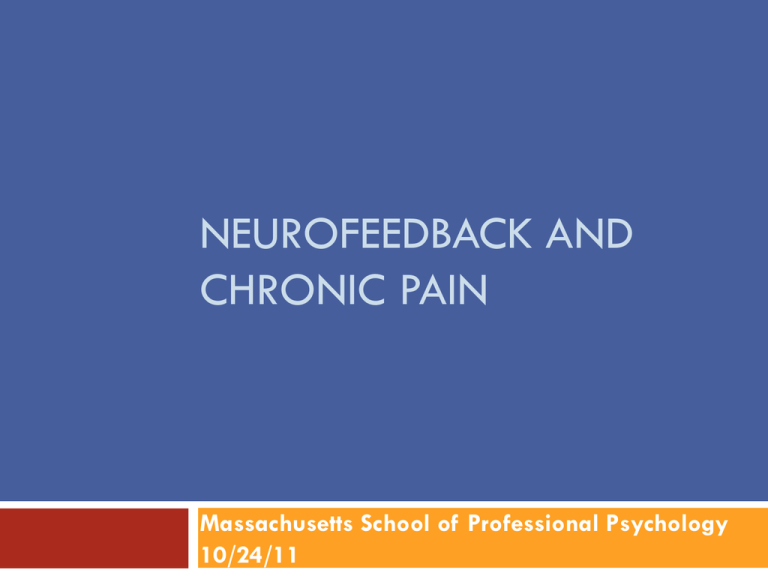
NEUROFEEDBACK AND CHRONIC PAIN Massachusetts School of Professional Psychology 10/24/11 Edward Jacobs, Ph.D., BCN Board Certied in Neurofeedback Edward Jacobs, Ph.D. & Associates 12 Parmenter Road Londonderry, NH 03053 (603) 437-2069 ext. 10 ehjpsych@aol.com www.jacobsassociates.org Acknowledgments Significant content was adapted from: Jensen, MP, Sherlin, LH, Hakimian, S & Fregni, F (2009). Neuromodulatory approaches for chronic pain management. Journal of Neurotherapy, 13,4 pp 196-213 and Neurofeedback in a Clinical Practice course syllabus, EEG Spectrum International, Spokane, WA Overview Cortical organization The EEG, brain wave frequencies Chronic Pain: Cortical basis Neurofeedback is biofeedback for the brain Neurofeedback history Neurofeedback and chronic pain: research Neurofeedback and chronic pain: case examples Overview National Institute of Neurological Disorders and Stroke of the National Institutes of Health “What is Chronic Pain? While acute pain is a normal sensation triggered in the nervous system to alert you to possible injury and the need to take care of yourself, chronic pain is different. Chronic pain persists. Pain signals keep firing in the nervous system for weeks, months, even years. There may have been an initial mishap – sprained back, serious infection, or there may be an ongoing cause of pain – arthritis, cancer, ear infection, but some people suffer chronic pain in the absence of any past injury or evidence of body damage. . . “ www.ninds.nih.gov/disorders/chronic_pain.htm Cortex Organization Cortex Organization Cortex Organization Subcortical Structures Pyramidal neuron Pyramidal neuron: approx. 100,000 neurons beneath each electrode Cortex Organization International 10-20 system of electrode placement The EEG The EEG Hans Berger German neuropsychiatrist 1924 demonstrated the existence of electric voltage fluctuations in the human brain. Published in 1929. recorded the first human electroencephalogram (EEG), which amplified tiny changes in electrical flow between a pair of electrodes placed on a patient's skull. Demonstrated EEG variations between normal and brain-injured patients, and between patients with their eyes open and eyes closed. The EEG EEG recordings represent electrical firings as waves, that reflect the frequency and amplitude of the signal. The EEG Frequency Measured in Hz The EEG Amplitude Measured in microvolts The EEG Phase The EEG Delta .5 – 4 Hz Slowest frequency band Most prominent during sleep Often associated with TBI Excessive delta while awake can interfere with processing The EEG Theta 4 - 7 Hz Internal locus Excessive theta: inattentive, distracted Increases when visualizing, imagining The EEG Alpha 8-12 Hz Transitional state between internal and external locus Relaxed, disengaged Slow alpha: inattentiveness, depression, lack of motivation, inefficient processing Fast alpha: calm, focused Different effects in different regions of the brain The EEG SMR (low beta) 12 – 15 Hz Calm, external attention Motor stillness Internal inhibition The EEG Beta 15 – 18 Hz Enhanced cognitive processing External focus with active engagement The EEG High beta 22 – 36 Hz High arousal state Tension, anxiety, fear, excitement The EEG EEG demonstration Chronic Pain: Cortical Basis Chronic Pain Neurophysiology of Pain: History Early 20th Century: Pain as simple reflexive response to physical damage Nociception transmitted from peripheral area of damage directly to brain Pain a function of the amount of damage or inflammation of the injured tissue Brain viewed as primarily a passive recipient of sensory information Chronic Pain Gate control theory (Melzack & Wall, 1965) Pain input modulated by spinal cord before reaching the brain Neuroimaging Role studies of the brain Pain influenced by multiple, interactive neural processes that modulate pain information at many levels, including the cortex Multiple cortical sites involved Somatosensory cortex sites, insular cortex, anterior cingulate, prefrontal cortex, thalamic nuclei Chronic Pain Apkarian, Bushnell, Treede & Zubeita, 2005 Craig, 2003a, b DeLeo, 2006 Katz & Rothenberg, 2005 Melzack, Coderre, Katz & Vaccarino, 2001 Miltner & Weiss, 1998 Rainville et al, 1997 Tinazzi et al, 2000 Chronic Pain Neural adaptation Neural networks response to repeated stimulation can be altered: CNS changes, neural plasticity Flor, 2003 Katz & Melzack, 1990 Increased sensitivity to noxious stimulation with repeated exposure Exposure to pain increases sensitivity to pain Contributes to chronicity Bromm & Lorenz, 1998 Chronic Pain Changes in CNS affects endocrine and immune systems Top-down regulation Fregna, Pascual-Leone & Freedman, 2007 Chronic Pain Plastic changes in neural network including areas concerning somatosensory and emotional processing Rome, HP & Rome, JD (2001) Neuroplastic processes in corticolimbic structures link the sensory and affective experiences of pain: “limbically augmented pain syndrome” Kindling Exposure to a noxious stimulus (emotional or physical trauma) results in a sensitized corticolimbic state Amplification, spontaneity, neuroanatomic spreading and cross-sensitization Treatment refractory pain Disturbances of mood, sleep, energy, libido, memory/concentration, behavior, stress tolerance Chronic Pain Overlap between depression symptoms and pain and the amelioration of pain symptoms with anti-depressants Lindsay & Wyckoff, 1981 Chronic Pain “. . . pain not only stimulates sensory areas of the brain but also powerfully activates brain areas involved in emotion, such as the anterior cingulate cortex (ACC), a region governing emotional aspects of pain, and the amygdala, which mediates fear and other feelings.” Porreca, F. and T. Price. When pain lingers. Scientific American. September 2009. Pp.34-41 Chronic Pain Fields, H. The psychology of pain. Scientific American Mind. September/October 2009. Pp. 42-49 “body’s pain-control circuit . . stretches from the brain’s cerebral cortex in the frontal lobes through underlying brain structures, including the periaqueductal gray, to the spinal cord, where pain-sensitive nerve fibers connect to neurons that transmit pain signals from the rest of the body . . .cognitive influences on pain operate through this modulatory pathway” Chronic Pain 10 OCTOBER 2003 VOL 302 SCIENCE www.sciencemag.org Does Rejection Hurt? An fMRI Study of Social Exclusion Eisenberger, Lieberman, Kipling, Williams “A neuroimaging study examined the neural correlates of social exclusion and tested the hypothesis that the brain bases of social pain are similar to those of physical pain. Participants were scanned while playing a virtual balltossing game in which they were ultimately excluded. Paralleling results from physical pain studies, the anterior cingulate cortex (ACC) was more active during exclusion than during inclusion and correlated positively with self-reported distress. Right ventral prefrontal cortex (RVPFC) was active during exclusion and correlated negatively with self-reported distress. ACC changes mediated the RVPFC-distress correlation, suggesting that RVPFC regulates the distress of social exclusion by disrupting ACC activity.” Chronic Pain Evidence of cortical involvement in the experience and amelioration of pain comes from successful clinical interventions that alter cortical activity fMRI studies (deCharms, et al, 2005): anterior cingulate Direct cortical electrical stimulation of the motor cortex (Nguyen et al, 1999; Nuti et al, 2005) Repeated Transcranial Magnetic Stimulation (rTMS) (Lefaucher et al, 2001; Pleger et al, 2004) Transcranial Direct Current Stimulation (tDCS) (Antal et al, 2001; Nitsche & Paulus, 2001) Chronic Pain Hypnosis (Montgomery et al, 2000; Patterson & Jensen, 2003; Jensen, Barber et al, 2008) Associated with reductions in cortical activity: PET and fMRI (Hofbauer et al, 2001; Rainville et al, 1997) Hypnotizable individuals show more theta and alpha activity before and during hypnosis (Crawford, 1990; Williams & Gruzelier, 2001) Chronic Pain Studies identifying the dorsal anterior cingulate cortex (dACC) fMRI feedback (DeCharmes et al, 2005) Standardized Low Resolution Electromagnetic Tomography (sLORETA) (Ozier et al, 2008) Implications for training at FZ or nearby (F1, F2) Chronic Pain Problems Invasive with these methods (direct cortical stimulation) Requires expensive equipment (rTMS, fMRI) Can be uncomfortable (rTMS, fMRI) Difficulty with “blinding” (rTMS) Many individuals are not hypnotizable (hypnosis) Chronic Pain Relationship between electroencephalographic activity and the experience of pain With more intense pain stimulation, all EEG frequencies increase in power, but beta activity increases more Alpha activity decreases Acute pain relief associated with decreases in beta and increases in alpha activity Bromm et al (1986), Bromm, Meier & Scharein (1986), Chang et al (2001), Chen et al (1983), Huber et al (2006), Bromm & Lorenz (1998), Chen (1993, 2001), Kakigi et al (2005), Pelletier & Peper (1997) Chronic Pain Subjective experience of pain associated with lower amplitudes of alpha and higher amplitudes of beta activity Chronic Pain Chronic pain associated with neurological disorders (e.g. spinal cord injury) show higher amplitude of theta activity in addition to higher amplitudes of beta and lower amplitudes of alpha Pain meds: the same pattern, but less severe Candidates for CLT (central lateral thalamotomy) Following surgery Reduction in pain Normalization of EEG patterns Chronic Pain Sarnthein et al (2006), Stern, Aufenberg et al (2006), Stern, Jeanmonod & Sarnthein (2006), Boord et al (2008) Chronic Pain Evidence shows that the experience of pain is linked to EEG activity Teaching patients to alter EEG activity to reflect activity that has been shown to be associated with reduced pain may be promising Neurofeedback History Neurofeedback History Classical conditioning of the human EEG: 1940’s Jasper & Shagass, 1941a Jasper & Shagass, 1941b Knott & Henry, 1941 Voluntary control over alpha blocking with subvocal verbal commands paired with visual cues (lights on/lights off) Classical conditioning, 1960’s Wyrwicka, Sterman & Clemente, 1962 Pairing neutral stimulus with electrical stimulation of basal forebrain resulted in this auditory stimulus inducing sleep preparatory behavior Neurofeedback History M. Barry Sterman, Ph.D. Professor UCLA, Departments of Neurobiology and Psychiatry Sleep research with cats Operantly conditioned cats to increase 12-15 Hz activity over the sensorimotor cortex (1967, 1968) Neurofeedback History Suppression of motor excitability with reductions in muscle tone, reflex amplitudes and cellular discharge in motor pathways that were associated with the learned EEG response Neurofeedback History M. Barry Sterman, Ph.D. Showed that operant conditioning of brainwaves could occur Showed specific effect of increasing one particular frequency Neurofeedback History M. Barry Sterman, Ph.D. NASA research Exposure to component of rocket fuel Monomethyl Hydrazine SMR trained cats more seizure resistant Average latency of convulsions was 3x greater in previously trained cats than in untrained cats 25% of trained cats were completely seizure free 75% of trained cats had 2x the latency of convulsions as controls Neurofeedback History M. Barry Sterman, PhD. 1972, 1974 conditioned EEG activity in humans Meta analysis of published studies in epilepsy 82% significant (>30%) reduction in seizures 50% average reduction in seizures and seizure severity 5% had complete control for up to one year Neurofeedback History Joe Kamiya’s research on alpha (1968) Conscious control over alpha activity Perceive when they increased alpha Neurofeedback History Joel Lubar’s (Univ. Tennessee) research on ADHD Increased theta, decreased beta at mid frontal cortex Increasing beta, decreasing theta results in amelioration of ADHD symptoms Neurofeedback History ADHD 10 published randomized control studies All showed significant reduction in symptoms 4 studies: neurophysiological changes associated with symptom reduction Only 3 studies: blinding and sham tx Small n Numerous clinical case studies reported Neurofeedback History Numerous clinical case studies in: depression, anxiety, LD, OCD, TBI, chronic pain, reactive attachment disorder, trauma survivors Neurofeedback & Chronic Pain Neurofeedback & Chronic Pain Andreychuk and Skriver, 1975 33 migraineurs Three treatments: Handwarming biofeedback Autogenic relaxation instructions Left and right occipital alpha enhancement feedback 10 30-minute sessions Headache reductions in all conditions Neurofeedback & Chronic Pain Melzack and Perry, 1975 24 patients, multiple chronic pain conditions Including chronic back pain, peripheral nerve injury, pain from cancer Three conditions Self-hypnosis and alpha enhancement neurofeedback Self-hypnosis alone Alpha enhancement alone Larger increases in alpha output and decreases in pain over the course of treatment for the hypnosis and neurofeedback group Neurofeedback & Chronic Pain Cohen, McArthur and Rickles, 1980 42 migraineurs One All of four biofeedback conditions Forehead cooling/handwarming Frontalis EEG reduction Temporal artery vasocontriction Alpha enhancement over right occipital and parietal lobes reported significant reduction in headaches No significant changes in alpha activity in neurofeedback group Neurofeedback & Chronic Pain Caro and Winter, 2001 15 fibromyalgia patients 40 or more sessions reinforcing 12-15 Hz (SMR or low beta) and inhibiting 4-7 Hz (theta) Significant improvement on a test of attention Strong correlation between improvements in attention and decreases in tender point scores Weak to moderate correlations between attention scores and patient ratings of fatigue Neurofeedback & Chronic Pain Sime, 2004 Case report, trigeminal neuralgia 29 neurofeedback and 10 biofeedback sessions Electrode placement and bandwidths varied Temporal lobe and sensory-motor strip electrode placements Consistent inhibits: 2-7 Hz (delta-theta) and 22-30 Hz (high beta) Rewarding 7.5-10.5 Hz activity (low alpha) at T3-T4 – most immediate pain reduction Patient decided to cancel planned surgery (severing trigeminal nerve) and discontinue pain medications Benefits maintained at 13 month follow up Neurofeedback & Chronic Pain Jensen et al, 2007 18 patients, Complex Regional Pain Syndrome Neurofeedback as part of multidisciplinary pain treatment program Varied protocols, individualized Pain assessed pre and post 30-min neurofeedback session 0 -10 pain scale at primary pain site and other sites Other symptoms measured Significant pain reduction reported at primary site Average intensity decreased from 5.2 to 3.2 Half of participants reported > 30 % pain reduction 5 of 7 secondary outcome measures showed statistically significant improvement after neurofeedback, including pain at other sites, muscle spasms, muscle tension and global well-being Neurofeedback & Chronic Pain Kayran et al, 2007 Case series: 3 patients with fibromyalgia Ten 30-min sessions rewarding SMR and inhibiting theta at C4 Each reported decreases in pain On 10 point scale, reductions were 4.0, 1.5 and 3.0 One participant showed minimal EEG changes Two participants showed minimal changes in SMR but significant reductions in theta Neurofeedback & Chronic Pain Migraine headaches Stokes (2010): combination of EEG neurofeedback and pIR HEG Carmen (2004): pIR HEG Neurofeedback is Biofeedback for the Brain Neurofeedback is biofeedback for the brain Biofeedback enables one to control unconscious, autonomous physiological processes by providing information about one’s physiological state to the conscious mind, which in turn enables the individual to alter the physiological state. Neurofeedback is biofeedback for the brain Operant conditioning Learned process Electrical activity, such as amplitude, is the behavior Visual, auditory or tactile feedback are the reinforcers Individual given feedback (reinforcers) when specific, identified brain electrical activity (brain wave frequency) is above a specified threshold (increasing), or below a specified threshold (decreasing) and is thus trained to increase or inhibit that activity Neurofeedback is biofeedback for the brain International 10-20 system of electrode placement Neurofeedback is biofeedback for the brain EEG Neurofeedback Train one site on the cortex to increase and/or decrease activity in certain frequency bands (single electrode placement) Neurofeedback is biofeedback for the brain Unipolar training Neurofeedback is biofeedback for the brain Train two sites on cortex simultaneously to increase or decrease the difference in amplitude between them (bipolar placements) Neurofeedback is biofeedback for the brain Bipolar training Neurofeedback is biofeedback for the brain Train two sites on cortex simultaneously in the same or different frequency bands or the relationship between them (two channel training) Neurofeedback is biofeedback for the brain Two channel training Neurofeedback is biofeedback for the brain Other possibilities (e.g. passive infrared hemoencephalography – pIR HEG) Neurofeedback is biofeedback for the brain EEG Neurofeedback Neurofeedback is biofeedback for the brain EEG Neurofeedback Neurofeedback is biofeedback for the brain EEG Neurofeed -back Neurofeedback is biofeedback for the brain EEG Neurofeed -back Neurofeedback is biofeedback for the brain Passive Infrared Hemoencephalography Clinical studies on migraine headaches Carmen, 2004 Stokes, 2010 Neurofeedback is biofeedback for the brain Passive Infrared Hemoencephalography Neurofeedback is biofeedback for the brain Passive Infrared Hemoencephalography Case Studies Case Studies Case Studies Neurofeedback Progress Chart: Matt Fleischman, PhD. Case Studies Neurofeedback progress chart Problem list in client’s words 0-4 scale 0 = not at all 1 = just a little 2 = some 3 = pretty much 4 = very much Case Studies Young adult female with gastrointestinal pain Adolescent male with testicular pain Middle age woman with migraines Pre-adolescent girl with migraines Case Studies Young adult female with gastrointestinal pain Presenting problems Chronic abdominal pain Depression Sharp, pulsing, aching 8/10 typical, daily Excessive sleep Lack of energy and motivation Missing school Case Studies CBT Several medication trials Case Studies Symptom Pain Depression Pre-Tx Rating 4 3 Case Studies F 1 T3 F Z CZ F 2 C4 P4 T4 Case Studies Course of treatment 41 sessions over 8 mos. 2x/wk. for approx. 16 wks. 1x/2wks. For approx. 12 wks. 1x/mo. For approx. 9 wks. Case Studies 3 sessions: T3-T4 rew. varied, 12-15 to 9-12, inh. 4-7, 22-32 Pain=4, Depression=3 2 sessions: CZ or FZ, rew. various beta frequencies, inh. 4-7, 22-32 Pain=4, Depression=3 5 sessions: FZ rew. 8-13 and various beta frequencies, inh. 4-7, 22-32 Pain=2, Depression=1 Case Studies 8 sessions: FZ rew. 8-13, 12-15, inh. 4-7, 22-32 Pain=2, Depression=0 3 sessions: 02 rew. 8-13 P4 rew. 8-13 FZ rew. 8-13, 12-15 inh. 2-7, 22-32 Pain= 3, Depression=4 7 sessions: C4 rew. 8-13, 12-15, inh. 2-7, 22-32 Pain=2, Depression=0 Case Studies 4 sessions: F1 & F2 rew. 8-13, inh. 4-7, 15-32 Pain=1, Depression=0 8 sessions: F1 & F2 rew. 8-12, inh. 0-7, 15-32 Pain=0, Depression=0 Case Studies Course of treatment First 4 sessions, slight increase in pain and depression symptoms Starting session 5: decrease pain and depression, more energy, more relaxed, improved sleep Session 17: took GED, Session 22: started looking for a job, pain more variable Session 24: started working 2 days/wk. Sessions 22-30: Pain flare ups but not as severe as before tx., feels manageable Session 39: stared college, 3 classes Session 41: getting A’s, registered for next semester Case Studies Symptom Pain Depression Pre-Tx Rating 4 3 Post-Tx Rating 0 0 Case Studies Adolescent male with testicular pain Presenting problems 2011, left testicular pain started in gym class, worst pain he had felt, crying Epididymitis, blood and protein in urine antibiotics, 3 courses, infection resolved Chronic, aching pain, sometimes surging Anti-inflammatory and pain meds Antidepressant and pain medication Pain from walking Half days of school Pain 4-6/10 even on pain meds Case Studies Symptom Pain Pre-Tx Rating 4 Case Studies F4 O1 O2 Case Studies Course of treatment Brain wave recordings High beta activity at posterior sites, including 01 & 02 F4 beta > F3 beta 22 sessions approx. 3 mos., approx. 2x/wk. 11 sessions 01 & 02, rew. 8-11, 10-13, inh. 4-7, 15-22 Pain=1 11 sessions F4, inh. 15-22 Pain=0 Case Studies Course of treatment After session 2: had exerted self more than usual, less pain and did not ice self. After session 3: Pain=2 Session 7: Pain=1 After session 11: Played more rigorous sportsand was not in pain. Session 13: Reported that he had stopped experiencing random bursts of pain unrelated to activity. Session 14: Playing sports with little pain. Dc’d antidepressant. Case Studies Course of treatment Session 15: Felt irritable off antidepressant, so resumed taking it. Session 16: Reported no pain except for 1x/wk. a sharp pain with no precipitant lasting 15-20 min. for which he took pain meds. Session 17: Pain=0 Session 18: Reported that pain was “nonexistent.” Sports activities with no pain. Session 21: Walking with no pain. One incident of pain, took pain med. Case Studies Symptom Pain Pre-Tx Rating 4 Post-Tx Rating 0 Case Studies Middle age woman with migraines Presenting problems Migraines 5x/wk. for approx. 30 yrs., can last all day Anxiety & depression triggered by family problems, teeth clenching, crying, overeating Sleep disturbance: onset and maintenance Migraines at night when lifts head off pillow, turns, gets out of bed Memory problems Fioricet Case Studies Symptom Pre-Tx Rating Migraine Physical anxiety symptoms Depression Sleep Overeating Organizational skills 4 4 4 4 4 3 Case Studies FP1 F3 T3 C3 FZ F4 C3 T4 Case Studies Course of treatment 32 sessions semi-weekly 5 sessions T3-T4, various inhibits (delta – alpha range), various rewards, changed frequencies depending on her response at the moment Difficulty controlling high beta activity, reporting a lot of stress and guilt about family responsibilities Headaches very variable Taught diaphragmatic breathing, HRV biofeedback Migraine = 2, Phys. anxiety = 2, Depression = 1, Sleep = 2, Overeating = 0, Organizational skills = 2 Case Studies Course of treatment 6 sessions combined T3-T4 2-7 inh., 7-10 rew. and FZ 1-7, 22-32 inh., no rew. or14-17 rew. Introduced handwarming at home Integrated simultaneous HRV into almost every neurofeedback session starting session 4 Headaches decreased in frequency, intensity and duration even as anxiety fluctuated Often felt headache coming on in a.m and aborted it for rest of day Depression decreased, could abort it, not occurring every day Migraine = 1, Phys. anxiety =2, depression = 0, Sleep = 2, Overeating = 4, Organization = 2 Case Studies Course of treatment 2 sessions combined T3-T4 2-7, 22-32 inh., 7-10 rwd. with F3-F4 2-7, 22-32 inh., 10-13 rwd. 12 sessions alternating HEG and T3-T4 or C3-C4 2-7 inh., 7-10 rewd., & FP1 4-8 inh., 15-18 rwd. At first, headache would start in a.m. then go away. Then had week with migraines for 4 days, all day, at 5/10 level. During this period, migraines highly variable, ranging from 0-3.5, overeating highly variable (0-3), depression 0, physical anxiety mostly 1-3, sleep 1-3, organization 2-3. Case Studies Course of treatment 5 sessions F3-F4 2-7 inh., 7-10 rwd. Severe headache approx. 1x/wk. Increased worry over family matters Headaches generally decreased intensity 50-75% Headaches generally decreased frequency 50-75% Migraine=0, Phys. Anxiety=2, Depression=3 (varied from 0-3), Sleep=0, Overeating=0, Organization=2 Last 2 sessions F3-F4, had started beta blocker Migraine=0, Phys. Anxiety=1. Depression=0, Sleep=0, Overeating=.5, Organization=2 Heart rate lower and more consistent Case Studies Symptom Pre-Tx Rating Migraine Physical anxiety symptoms Depression Sleep Overeating Organizational skills 4 4 4 4 4 3 Post-Tx Rating 0 1 0 1 0.5 2 Case Studies Girl with migraines Presenting problems Headaches every day since last day of school last year until present (Nov.) Vomited, went to sleep Mid-frontal, spread bilaterally Wakes up with HA, lasts all day 6/10 usually Stomach aches Derealization (self and others) Smells, lights dimming (tunnel vision) Case Studies Presenting OCD problems symptoms Anxiety attacks Fears Sleep problems Poor appetite but always hungry Teased by peers Case Studies History Extensive Prior family history of migraines and anxiety treatment Counseling past three and a half years Two prior courses of therapy Case Studies Symptom Obsessive Pre-Tx Rating thoughts Fears Unreal feeling & headache Panic Attacks Depression Compulsions Social discomfort 4 3.5 3 3 4 2.5 2.5 Case Studies F3 FZ F4 FCZ T3 C3 CZ C4 T4 Case Studies Course of treatment 53 nfb sessions to date twice weekly for about 36 sessions, weekly for about 16 session, now every 2-3 weeks qEEG (brain map) recorded Four sessions pIR HEG (sessions 45-48) Psychotherapy integrated about half way through tx Hand warming taught and encouraged at home Headache journal prescribed Case Studies qEEG recording 1-6 Hz activity at midline, does not block with EO Absolute delta deceased in medial & temporal regions Theta/beta ratios elevated in anterior midline Relative theta elevated frontally Hypocoherence of delta in anterior temporal regions Case Studies Course of treatment Sessions 1-7 C3, C4, T3-T4 various frequencies After session 1, headache rated 0 Session 6 qEEG results rec’d, started CZ 4-7 inh., 15-18 rwd. Derealization feelings decreased Sleep improved – onset and maintenance Case Studies Sessions 8-34, various frontal placements in various combinations at various frequencies (F3, F4, FZ, FCZ) Irritability, low self-esteem, depression, fears of not getting better Depression when having fun, sad about things ending Somatic complaints Anxiety at night Extreme social fears Negative cognitive set Headaches tension not migraine Case Studies Sessions 35-43 T4 4-7 inh., 1-4 rwd. with one HEG session Migraine Discussion between sessions 42 & 43 of family issues in tx Fearful of being normal Fearful of eating and growing Discussed interactions with mother Case Studies Course of treatment Session 44 F3 4-7, 22-32 inh., 1518 rwd. Sessions 45-48 pIR HEG Sessions 49-53 T3-T4 4-7, 22-32 inh., 11-14 or 10-13 rwd. Case Studies Symptom Obsessive thoughts (general) Fears Unreal feeling & headache Panic Attacks Depression Compulsions Social discomfort Pre-Tx Rating 53 Week Rating 4 3.5 3 3 4 2.5 2.5 2 2 1.5 1.5 2 2 2.5 Case Studies Outcome No migraine headaches after first few sessions until one event between sessions 42 & 43 Became more consistent in practicing hand warming and her exposure exercises Wider social circle Better able to tolerate peer conflicts Affect more animated, greater range and variation Still significant social anxiety, self-esteem problems Conclusions Emerging clinical and experimental literature is promising regarding efficacy Consistent with neurophysiological literature and learning theory Relatively low cost Few groups of individuals that would be unsuitable Non-invasive Minimal side effect risk Suitable for patients who may be in too much discomfort to tolerate talk therapy and may enable them to eventually make use of talk therapy. Thanks for your attention!

